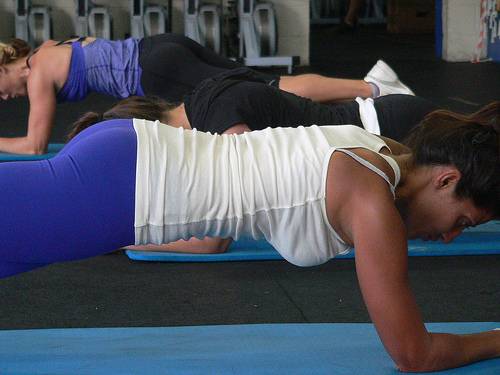Drew Baye is the President of Drew Baye’s High Intensity Training and one of the smartest science-based professionals in the business. Drew designed the UXS bodyweight training device and the Kratos bodyweight training program. I recently had the opportunity to talk with Drew, so I asked him questions I thought the readers of Breaking Muscle might enjoy learning the answers to.
Tom: Drew, please offer our readers an overview of your education and background in the fitness industry:
Drew: I started training people twenty years ago while studying biology and exercise physiology at the University of Wisconsin, Green Bay, which I left to work with and learn from former Nautilus researcher Ken Hutchins. During that time I’ve trained hundreds of people ranging from post-rehab clients and weekend warriors to professional athletes, and have consulted for people and companies all over the world.
Tom: Please offer your researched-based bottom line on muscle fiber activation and exercise repetition speed.
Drew: Muscle fiber recruitment is dependent on force requirements, and not repetition speed. As long as a muscle is required to produce enough force all of the motor units in the muscle will be recruited regardless of the speed of contraction. It is not necessary to move quickly during exercise to recruit the high-threshold, fast-twitch motor units. In fact, they can be recruited during isometric contractions as long as the level of effort is high enough, which is as slow as it gets.
Tom: For the hard-core CrossFit clan who espouse ballistic training, what advice can you offer them?
Drew: You can get stronger and better conditioned training fast or slow, but if you value your long-term joint health and functional ability, you should avoid exercises or protocols that involve ballistic or explosive movements or that rely heavily on momentum. Weights should be lifted under strict control, not jerked, heaved, swung, or thrown. There is no general physical conditioning or health advantage to moving quickly during exercise and the speed of movement during exercise does not transfer to other movements or activities, but moving quickly does reduce the efficiency of muscular loading and increase the wear and tear on the joints and risk of injury.
Tom: If you mentioned the name Arthur Jones, founder of Nautilus, my guess is most readers would draw a blank. In my opinion, that is sad because they have not studied the history of the strength-training field and therefore are not fully enlightened when it comes to modern-day controversies. In example, what are your thoughts on the idea that moving a resistance quickly would develop the expression of muscular power?
 Drew: It is unfortunate, because like the saying goes those who don’t know history are doomed to repeat it, and in the field of exercise people have been making the same mistakes over and over for decades. It has been known for a long time you don’t need to move fast during exercise to improve speed or power in other activities, but the myth persists and is still taught by many organizations. This is something Jones disproved and wrote about in his Athletic Journal articles and Nautilus Bulletins forty years ago, but as Mark Twain wrote, “It is easier to fool people than to convince them that they’ve been fooled.”
Drew: It is unfortunate, because like the saying goes those who don’t know history are doomed to repeat it, and in the field of exercise people have been making the same mistakes over and over for decades. It has been known for a long time you don’t need to move fast during exercise to improve speed or power in other activities, but the myth persists and is still taught by many organizations. This is something Jones disproved and wrote about in his Athletic Journal articles and Nautilus Bulletins forty years ago, but as Mark Twain wrote, “It is easier to fool people than to convince them that they’ve been fooled.”
How fast you are capable of moving and thus your power output is directly related to the amount of force the involved muscles are capable of producing and how quickly the force can be increased. Both of these can be improved in general without moving quickly during exercise. Muscular strength can be improved at any speed or none at all using isometrics, and rate of force development can be improved as long as the intended speed is high, even if the actual speed is not, as is the case during the last few repetitions of an exercise when, if the weight selection is appropriate, even though you are attempting to move quickly the resulting speed should actually be quite slow.
Tom: Males versus females regarding hard training and bulking up. To this day I still get the impression that females think they will achieve large muscles by working hard and heavy.
Drew: While most women have the potential to become much stronger and improve their body composition and shape considerably with proper training, it is very rare for a woman to develop large muscles or become “bulky” because most do not have the hormonal make up necessary to do so. Those who do are often easy to identify because they tend to be unusually muscular before they do any exercise at all.
Tom: Reducing body fat. What is your advice?
Drew: If a person wants to reduce body fat they should gradually reduce their overall calorie intake until they are steadily losing a small amount of fat per week, but not so much it impairs their physical or mental performance. They should eat mostly real food, with an emphasis on meat, eggs, fish, and vegetables, fruits, and nuts to maximize nutrient density and create a hormonal environment conducive to improving body composition and which minimizes hunger. This, combined with proper strength training to maintain lean body mass while fat is lost, is all that is needed.
Tom: What are your thoughts on improving strength and athletic performance?
 Drew: There isn’t a single athletic activity that wouldn’t benefit from increased strength, but while strength is important, I think it is even more important for a strength and conditioning program to increase athlete’s resistance to injury. This includes both focusing on strengthening areas where injury is most likely and avoiding causing injuries or precipitating them during the workouts. Unfortunately, this is an area where many programs fail due to the inclusion of many explosive and so-called “functional” exercises that pose a greater risk of injury without providing any general physical advantage over conventional free-weight and machine exercises. I suspect many of the injuries that appear to occur on the field, court, track, etc. originate in the weight room.
Drew: There isn’t a single athletic activity that wouldn’t benefit from increased strength, but while strength is important, I think it is even more important for a strength and conditioning program to increase athlete’s resistance to injury. This includes both focusing on strengthening areas where injury is most likely and avoiding causing injuries or precipitating them during the workouts. Unfortunately, this is an area where many programs fail due to the inclusion of many explosive and so-called “functional” exercises that pose a greater risk of injury without providing any general physical advantage over conventional free-weight and machine exercises. I suspect many of the injuries that appear to occur on the field, court, track, etc. originate in the weight room.
Tom: We live in a society replete with specious exercise recommendations and results, a la nauseating infomercials and grocery store magazines. What advice would you offer readers?
Drew: I would advise the readers to spend at least as much time studying logic and critical thinking skills as they do reading up on exercise so they are better able to distinguish between science and bunk. Doing so will enable them to make more informed and better decisions about their training and get the results they want faster and more efficiently and probably avoid a lot of injuries in the long run.
Tom: I thank you for your candid thoughts, Drew.
Drew: You’re welcome, and I’ll be glad to stop by and answer any follow up questions the breakingmuscle readers may have.
For more bodyweight trainign discussions and presentations from Drew click here.
Photo 1 provided by Drew Baye.
Photos 2 & 3 provided by CrossFit LA.






